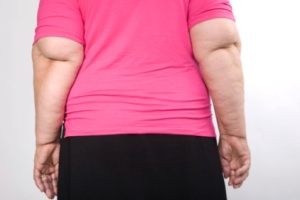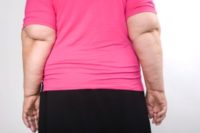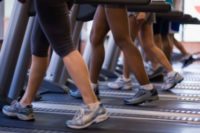 Weight loss and increased physical fitness nearly halved the risk of losing mobility in overweight or obese adults with type 2 diabetes, according to four-year results from the Look AHEAD (Action for Health in Diabetes) trial funded by the National Institutes of Health. The results are published in the March 29, 2012, issue of the New England Journal of Medicine.
Weight loss and increased physical fitness nearly halved the risk of losing mobility in overweight or obese adults with type 2 diabetes, according to four-year results from the Look AHEAD (Action for Health in Diabetes) trial funded by the National Institutes of Health. The results are published in the March 29, 2012, issue of the New England Journal of Medicine.
"Being able to perform routine activities is an important contributor to quality of life," said Griffin P. Rodgers, M.D., director of the NIH's National Institute of Diabetes and Digestive and Kidney Diseases (NIDDK), which led the study. "These findings add support to making lifestyle changes that improve health and reduce disability in people with type 2 diabetes, changes that already have been shown to prevent the disease and provide a good return on investment."
Look AHEAD is a multi-center, randomized clinical trial designed to determine the long-term effects of intentional weight loss on the risk of developing cardiovascular disease in overweight and obese individuals with type 2 diabetes. Beginning in 2001, a total of 5,145 participants were randomly assigned to either an intensive lifestyle intervention group (ILI) or a diabetes support and education group (DSE). Participants receiving the intervention attended group and individual meetings to achieve and maintain weight loss through decreased caloric intake and increased physical activity. The DSE group attended three meetings each year that provided general education on diet, activity, and social support.
To assess mobility and disability, participants rated their ability to carry out activities with or without limitations. Included were vigorous activities such as running and lifting heavy objects and moderate ones such as pushing a vacuum cleaner or playing golf. Participants also separately rated their ability to climb a flight of stairs; bend, kneel or stoop; walk more than a mile; and walk one block. Both groups were weighed annually and completed a treadmill fitness test at baseline, after one year, and at the end of four years.
After four years of the study, participants in the ILI group experienced a 48 percent reduction in mobility-related disability compared with the DSE group. Furthermore, 20.6 percent of ILI participants reported severe disability compared to 26.2 percent of participants in the DSE group. Likewise, 38.5 percent of those in the ILI group reported good mobility, whereas the rate was 31.9 percent in the DSE group. Weight loss was a slightly stronger predictor of better mobility than improved fitness, but both contributed significantly to the observed reduction in risk.
"With nearly two-thirds of participants reporting mild, moderate, or severe restrictions in mobility when Look AHEAD began, it is critical to address this problem," said Mary Evans, Ph.D., project scientist for the study."This study of mobility highlights the value of finding ways to help adults with type 2 diabetes keep moving as they age. We know that when adults lose mobility, it becomes difficult for them to live on their own, and they are likely to develop more serious health problems, increasing their health care costs."
Overweight and obesity affects more than two-thirds of U.S. adults age 20 and older. More than one-third of adults are obese. Many factors contribute to the problem, including genetics, lifestyle habits, and the food environment. Excess weight can lead to type 2 diabetes, heart disease, high blood pressure, stroke, and certain cancers. Nearly 26 million Americans have diabetes, and 7 million of them do not know it.
"The weight loss and physical activity goals promoted in the study are well within the reach of most Americans," said Jack Rejeski, Ph.D., lead author and Thurman D. Kitchin professor of health and exercise science at Wake Forest University, Winston-Salem, N.C. "Future research is needed to determine if this sort of intervention can be translated into public health interventions, particularly in light of possible effects on health care costs."
Find more information about the Look AHEAD trial go to: lookaheadtrial.org. Learn more about diabetes and maintaining a healthy weight at diabetes.niddk.nih.gov, from the National Diabetes Education Program at Yourdiabetesinfo.org, from the National Institute on Aging at nia.nih.gov/Go4Life, and from the Weight-control Information Network at win.niddk.nih.gov.
The NIDDK, part of the NIH, conducts and supports basic and clinical research and research training on some of the most common, severe and disabling conditions affecting Americans. The Institute's research interests include: diabetes and other endocrine and metabolic diseases; digestive diseases, nutrition, and obesity; and kidney, urologic and hematologic diseases. For more information, visit www.niddk.nih.gov.
About the National Institutes of Health (NIH): NIH, the nation's medical research agency, includes 27 Institutes and Centers and is a component of the U.S. Department of Health and Human Services. NIH is the primary federal agency conducting and supporting basic, clinical, and translational medical research, and is investigating the causes, treatments, and cures for both common and rare diseases. For more information about NIH and its programs, visit www.nih.gov.
Weight loss, increased fitness help aging type 2 diabetics stay mobile



